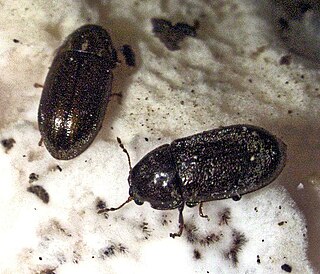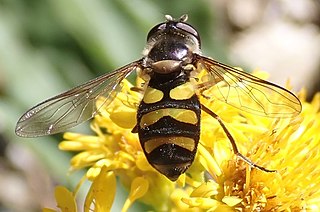
The bush rat or Australian bush rat is a small Australian nocturnal animal. It is an omnivore and one of the most common indigenous species of rat on the continent, found in many heathland areas of Victoria and New South Wales.

The Scathophagidae are a small family of Muscoidea which are often known as dung flies, although this name is not appropriate except for a few species of the genus Scathophaga which do indeed pass their larval stages in animal dung. The name probably derives from the yellow dung fly, which is one of the most abundant and ubiquitous flies in many parts of the Northern Hemisphere.

The minute black scavenger flies or "dung midges", are a family, Scatopsidae, of nematoceran flies. Despite being distributed throughout the world, they form a small family with only around 250 described species in 27 genera, although many await description and doubtless even more await discovery. These are generally small, sometimes minute, dark flies, generally similar to black flies (Simuliidae), but usually lacking the humped thorax characteristic of that family.

The dusky-footed woodrat is a species of nocturnal rodent in the family Cricetidae. Nicknames include "packrats" or "trade rats" because of their tendency to hoard things, build large domed dens, and "trade" by dropping then picking up another object for it. Coyotes and other predators will attempt to prey on these rodents by laying waste to the dens, but the sheer volume of material is usually dissuasive. Occasionally, dusky-footed woodrats will build satellite dens in trees. Although these animals are solitary, except in the mating season, dens are frequently found in clusters of up to several dozen, forming rough "communities". The mating system in this species appears to be variable, with promiscuity most generally at high population densities and monogamy at lower densities.

The big-eared woodrat is a nocturnal rodent of the woodrat genus Neotoma, in the family Cricetidae. Closely related to, and formerly included in the species Neotoma fuscipes, it is endemic to western North America and occurs west and south of the Salinas Valley from the California Coast Ranges south of Monterey Bay to northern Baja California, as well as in the Sierra Nevada, extending north to the South Fork American River.

Agapetus is a genus of little black caddisflies of the family Glossosomatidae. There are at least 210 described species in Agapetus.
Nerthra fuscipes is a species of toad bug in the family Gelastocoridae. It is found in the Caribbean, Central America, North America, and South America.

Aeoloplides is a genus of spur-throated grasshoppers in the family Acrididae. There are about nine described species in Aeoloplides.
Aeoloplides fuscipes, the southern coast bush grasshopper, is a species of spur-throated grasshopper in the family Acrididae. It is found in North America.

Scathophaginae is a subfamily of dung flies in the family Scathophagidae. There are at least 30 genera and 130 described species in Scathophaginae.
Cordilura setosa is a species of dung fly in the family Scathophagidae.

Cordilura is a genus of dung flies in the family Scathophagidae. There are more than 90 described species in Cordilura.
Cordilura munda is a species of dung fly in the family Scathophagidae.

Cis fuscipes, the minute tree-fungus beetle, is a species of minute tree-fungus beetle in the family Ciidae. It is found in Australia, the Caribbean, North America, Oceania, and Europe.
Cordilura varipes is a species of dung fly in the family Scathophagidae.
Pachybrachis fuscipes is a species of case-bearing leaf beetle in the family Chrysomelidae. It is found in North America.
Cordilura scapularis is a species of dung fly in the family Scathophagidae.

Didea fuscipes is a species of syrphid fly in the family Syrphidae.
Cordilura emarginata is a species of dung fly in the family Scathophagidae.
Glossina fuscipes is a riverine fly species in the genus Glossina, which are commonly known as tsetse flies. Typically found in sub-Saharan Africa but with a small Arabian range, G. fuscipes is a regional vector of African trypanosomiasis, commonly known as sleeping sickness, that causes significant rates of morbidity and mortality among humans and livestock. Consequently, the species is among several being targeted by researchers and veterinary and public health authorities for population control as a method for controlling the disease.









